I/O Multiplexing
1. Introduction
TCP中常常要面对这样一个问题: 多个file或socket需要同时处理. 例如: TCP client需从standard input中获取用户输入, 并读取来自socket的数据, 这种同时应对多个I/O conditions的能力称为I/O multiplexing(I/O多路复用).
I/O multiplexing主要用于network application的以下场景:
- client处理多个descriptor
- 处理多个socket
- TCP server处理listening socket和其connected socket
- server同时处理TCP和UDP
- server同时处理多个protocols
2. I/O Models
以下是UNIX中的5种I/O Model:
- blocking I/O
- nonblocking I/O
- I/O multiplexing (select and poll)
- signal driven I/O (SIGIO)
- asynchronous I/O (the POSIX
aio_functions)
无论是哪种I/O model, 所有读取操作都可拆分为以下步骤:
- 等待数据就绪(network application中为等待数据到达socket)
- 将数据从kernel复制到process中
2.1 Blocking I/O Model
Blocking I/O model是最常见的I/O model, 实现方式最简单. 以datagram socket为例, 读取操作的流程如下: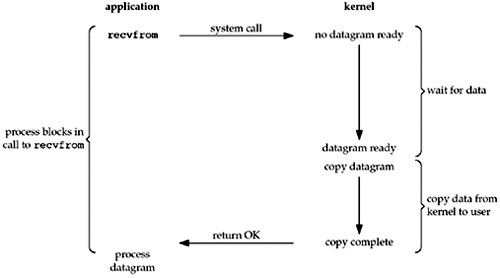
上述例子中, 调用recvfrom()会等待数据到达socket, 并主动将数据从kernel复制到process. 进程必须等待recvfrom()完成, 或被signal打断.
2.2 Nonblocking I/O Model
Nonblocking I/O model不阻塞进程, 进程立即获得结果. 以下是读取操作的流程: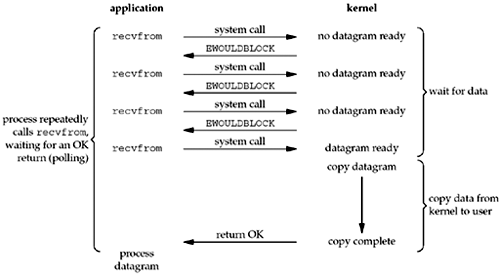
前三次调用recvfrom()时, 由于socket未收到数据, kernel返回EWOULDBLOCK; 第四次调用recvfrom(), 其会将数据从kernel复制到process中. Nonblocking I/O model永不挂起的特性使得程序必须使用loop不断调用recvfrom(), 称为polling, 虽然不会长时间挂起, 但浪费CPU时间.
2.3 I/O Multiplexing Model
I/O Multiplexing model中, 进程使用select或poll阻塞多个system call. 以下是读取操作的流程: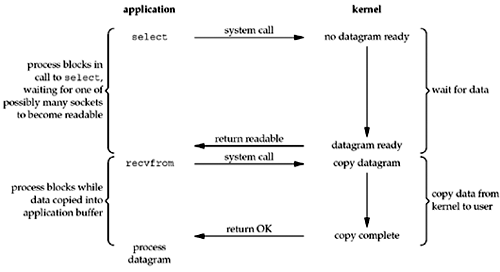
上述例子使用select()监听多个sockets, 一旦socket处于readable状态, 则通知进程并调用recvfrom(), 将数据从kernel复制到process中. 虽然select()阻塞进程, 但select()能够同时监听多个socket, multithreading blocking I/O可实现相同效果, 但更消耗资源.
2.4 Signal-Driven I/O Model
Signal-driven I/O model通过SIGIO signal提醒进程file descriptor已准备就绪. 以下是读取操作的流程: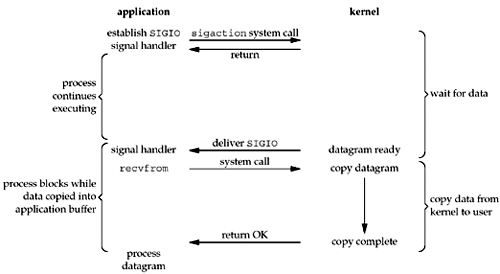
首先调用sigaction()设置一个signal handler, 该操作不会阻塞进程; socket收到数据时, 进程会收到SIGIO, 调用signal handler中的recvfrom(), 其将数据从kernel复制到process. 该model的优点在于不用阻塞进程, 但需设置signal handler.
2.5 Asynchronous I/O Model
POSIX.1定义了该I/O model: asynchronous function通知kernel开始读取操作, 操作完毕后, kernel通知function. 与signal-driven I/O model不同的是: asynchronous I/O会完成所有任务(等待数据, 将数据从kernel复制到process); signal-driven I/O则需手动读取数据.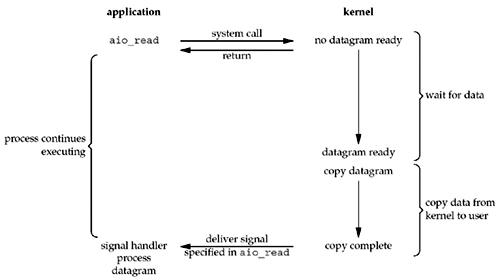
POSIX.1的所有asynchronous I/O function以aio_或lio_开头, 且不会阻塞进程, 结束时用signal通知进程.
2.6 Comparison of the I/O Models
以下是5种I/O models的读取操作对比: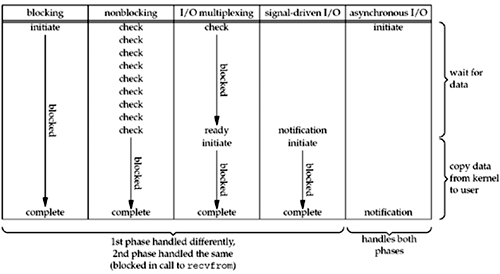
3. select Function
进程调用select()可通知kernel等待一个或多个事件发生, 当其中一个或多个事件发生时, 进程会被唤醒. select()可监听file descriptor的三种事件:
- read
- write
- exception
|
以下是select()的三种等待情况:
- 无限等待: 若
timeout为NULL, 除非某个file descriptor处于ready状态, 否则select()会一直等待 - 最多等待一定时间: 若
timeout指定的timevalstruct不为0, 即便没有file descriptor处于ready状态,select()也会返回 - 不等待: 若
timeout指定的timevalstruct为0,select()立刻返回, 称为polling
若进程捕获到signal并从signal handler返回, 则自动打断select()并设置相应errno. select()中的readfds, writefds和exceptfds分别监听read, write和exception事件, 其中exception包含以下情况:
- socket收到out-of-band data
- packet mode下pseudo-terminal master收到control status information
select()通过fd_set设置或清除某个file descriptor的监听, 每个file descriptor占fd_set的一个bit; 当某个file descriptor被添加到readfds和writefds时, 表示同时监听该file descriptor的read和write事件. 以下是socket处于ready状态的几种情况:
- socket处于readable状态:
- socket receive buffer中的字节数大于或等于low-water mark. Send buffer的low-water mark可通过SO_RCVLOWAT socket option设置, 默认为1.
- socket收到FIN后(TCP connection),
read()不会阻塞, 返回0 - 当socket调用
listen()变为passive listening socket, 且有一个或多个connection时,accept()不会阻塞 - 存在socket error时,
read()不会阻塞, 返回-1
- socket处于writable状态:
socket send buffer中空闲空间大于或等于low-water mark, 且满足以下其中一个条件:
- socket已连接
- socket不需要连接(如: UDP)
Receive buffer的low-water mark可通过
SO_SNDLOWATsocket option设置, 默认为2048.socket已关闭连接, 调用
write()会产生SIGPIPEsignalsocket调用non-blocking connect建立连接
存在socket error时,
write()不会阻塞, 返回-1
- socket处于exception状态: socket接收到out-of-band data
以下是socket状态的总结:
| Condition | Readable | Writable | Exception |
|---|---|---|---|
| Data to read | ✔ | ||
| Read half of the connection closed | ✔ | ||
| New connection ready for listening socket | ✔ | ||
| Space available for writing | ✔ | ||
| Write half of the connection closed | ✔ | ||
| Pending error | ✔ | ✔ | ✔ |
| TCP out-of-band data | ✔ |
4. str_cli Function (Revisited)
以下是使用select()重写后的TCP client:
void str_cli(FILE *fp, int sockfd) |
TCP client中要监听socket descriptor和stdin是否处于readable, 以下是socket处于readable状态的三种情况:
- 对端TCP socket发送数据,
read()返回值大于0 - 对端TCP socket发送FIN,
read()返回0 - 对端TCP socket发送RST,
read()返回-1
5. Batch Input and Buffering
使用select()后, TCP client端就从stop-and-wait mode变为batch mode(批量模式). 之前server和client每次通信需要1个RTT时间, 但batch mode下数据以最快速度传输, 如下图: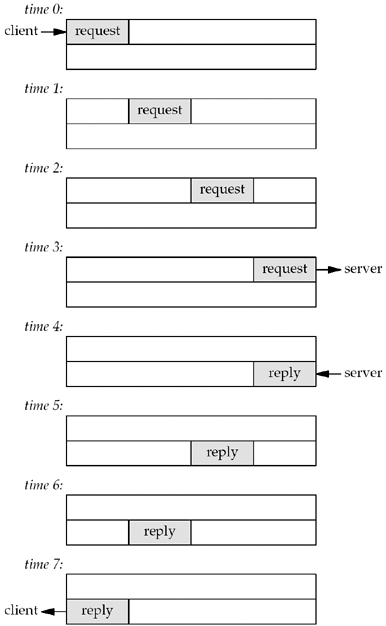
但batch mode存在一些问题:
- 向stdio输入EOF时, 会导致connection完全关闭, 从而导致request还没发出, 或丢失还没接收的数据. 解决方案: 使用
shutdown()向server发送FIN, 关闭one-half of the TCP connection, 这样可让client端的socket继续接收数据 - buffering虽然提高network application的性能, 但增加了复杂度. 若stdio buffer中存在多行数据,
select()只会被唤醒一次, 并调用fgets()从stdio中读取一行数据, 剩下的数据依然留在stdio buffer中. readline()也存在buffer的问题: 由于readline()有自己的buffer, 所以需修改其实现.
6. shutdown Function
正常情况下, network application会调用close()来关闭connection, 但close()存在以下两个缺陷:
close()只会减少descriptor的reference count, 只有reference count降为0时, descriptor才会被关闭;shutdown()则直接开始TCP connection termination.close()会停止双向数据传输(read和write). 当socket发送完数据后仍需接收数据, 则不能调用close()关闭connection
|
7. str_cli Function (Revisited Again)
使用shutdown()改写后的str_cli()如下:
void str_cli(FILE *fp, int sockfd) |
8. TCP Echo Server (Revisited)
TCP server也可用select()改写, 来替代client connection线程. 由于server端不需要监听写入操作, 所以只需要维护一个read descriptor set. 其中, 前三个file descriptors为stdio, stdout, stderr, 第四个file descriptor为listening descriptor; 剩下的descriptor为connected socket descriptor. 例如: client数组存储connected socket descriptor, rset维护read descriptor set, 如下图:
client数组中, -1表示不可用file descriptor; rset中, 0表示不监听该file descriptor, 1表示监听该file descriptor. 当client1与server建立连接后, server会将该connected descriptor添加到client和rset中, 如下图: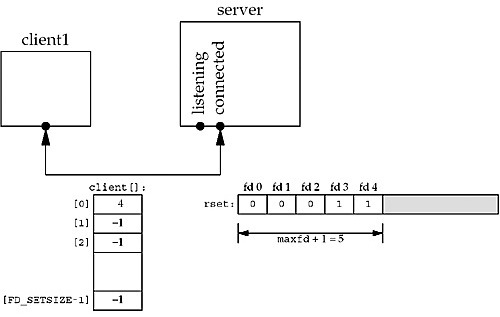
一段时间后, client2与server建立连接, 情况如下: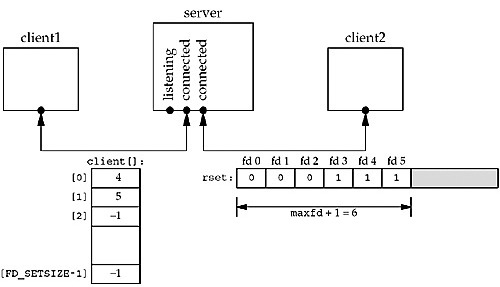
client1与server断开连接, client[0]置为-1, rset中descriptor 4置为0, 如下图:
使用select()的TCP server端代码如下:
int main(int argc, char **argv) |
9. pselect Function
POSIX.1引入了pselect(), 并在很多UNIX系统中使用.
|
虽然pselect()功能上与select()相同, 但存在以下几点不同:
select()使用struct timeval(仅支持microseconds)作为timeout类型;pselect()则使用struct timespec(支持nanoseconds)select()没有sigmask参数,pselect()则支持屏蔽特定signal
需要注意:
ready = pselect(nfds, &readfds, &writefds, &exceptfds, timeout, &sigmask); |
相当于原子性地执行以下代码:
sigset_t origmask; |
可以看出, pselect()的sigmask只用于运行时, 调用结束后会恢复原本的signal mask; select()不会修改signal mask. 这导致一个问题: 假设某个signal已经被block, 但又需要select()运行时捕获该signal, 则需要调用sigprocmask()解除signal的block, 并在select()运行结束后调用sigprocmask()恢复对该signal的block. 因而产生了两个race condition:
- 解除阻塞signal后, 调用
select()前signal到达, 导致signal丢失 select()调用后, 重新阻塞signal前signal到达, 导致signal丢失
因此引入pselect()解决该问题.
10. poll Function
|
pollfd struct不仅包含file descriptor, 还包含可监听事件(events)与已发生事件(revents). 以下是事件(event)分类:
| Constant | events | revents | Description |
|---|---|---|---|
| POLLIN | ✔ | ✔ | Normal or priority band data can be read |
| POLLRDNORM | ✔ | ✔ | Normal data can be read |
| POLLRDBAND | ✔ | ✔ | Priority band data can be read |
| POLLPRI | ✔ | ✔ | High-priority data cab be read |
| POLLOUT | ✔ | ✔ | Normal data can be writen |
| POLLWRNORM | ✔ | ✔ | Normal data can be writen |
| POLLWRBAND | ✔ | ✔ | Priority band data can be writen |
| POLLERR | ✔ | Error has occurred | |
| POLLHUP | ✔ | Hangup has occurred | |
| POLLNVAL | ✔ | Descriptor is not an open file |
poll()将所有数据分为三种: normal, priority band, 和high-priority. 对于TCP或UDP数据, POSIX.1的poll()将其分类如下:
- 所有TCP和UDP数据都为normal
- TCP的out-of-band data为priority band
- TCP connection被中断(例如, 收到FIN)也是normal
- TCP connection发生的error(例如, 收到RST或超时)可被当做normal, 也可被当做POLLERR
- listening socket收到新的connection时, 可被当做normal或priority band
- nonblocking connect的执行完毕会让socket处于可写状态
timeout参数表示poll()在返回前等待多长时间:
| timeout value | Description |
|---|---|
| INFTIM | Wait forever |
| 0 | Return immediately, do not block |
| > 0 | Wait specified number of milliseconds |
11. TCP Echo Server (Revisited Again)
以下为poll()替代select()后的TCP server:
int main(int argc, char **argv) |